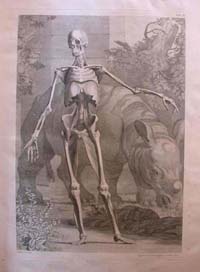|
|
|
Albinus’s father was Professor of Medicine at Leiden and he himself entered the university at the age of twelve, receiving his medical degree in 1719 without sitting any examinations. At the age of twenty-four he was appointed to the chair of anatomy and surgery.
Albinus’s plan to publish an atlas of anatomy which bettered earlier works was long in its gestation, taking eight years to produce the 28 plates of the Tabulae sceleti et musculorum. In it with the collaboration of the artist Jan Wandelaar he attempted a new approach to the depiction of the human anatomy, starting not with the outer integument and working inwards revealing progressively deeper layers, but taking as his point of departure the skeleton, which he considered ‘the foundation to build my figures upon.’
Click on thumbnail for larger image.
|
|

Tables of the skeleton and muscles of the human
body.
London, 1749. Table 4 [in Az.1.6]
English translation of Tabulae sceleti et musculorum.
Leiden, 1747.
|
The landscape backgrounds were Wandelaar’s idea, and were intended to relieve the harshness of the figures by providing the illusion of three dimensionality. The figure, which in this plate reveals the fourth order of the muscles, stands out prominently against the background in which the female rhinoceros, seen by Albinus in 1742, is blithely grazing. The plates in this pirated English edition were by the French engraver, Charles
Grignion.
|